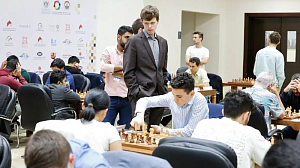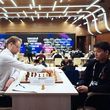Ian Nepomniachtchi Takes Over Ding Liren in Game Seven
The overall score is 4:3 in favour of the Russian GM.
Rumours about seeing the last of classical chess have been greatly exaggerated. With half the match over and seven out of fourteen games planned finished, the contenders have drawn only two of them.
Uncharacteristically, Ding Liren was the first to show up for game seven, which was five minutes before they started the clock. Ian arrived next with a thermos in each hand. He placed them on a special table and even managed to take off his jacket before his opponent did. Ding immediately followed suit. Jeroen van den Berg, a many-year director of the Wijk aan Zee Chess Festival and currently a person in charge of the Appeals Committee in Astana, made the symbolic first move e2-e4. His guess was correct, because Ian has nothing to complain about the king's pawn advance: he had won one game, and had had a good chance of winning yet another one. Both those games would open into the Ruy Lopez. This time Ding decided against sounding like a broken record.
The Chinese grandmaster contemplated for a minute, staring at the chessboard, and ended up moving his e-pawn one square forward. The French Defence is a rare guest in Ding Liren's praxis of the latest decade! That said, Ian Nepomniachtchi used to play it a lot as Black and quite successfully at that (especially in his youth) and even chose it as his main weapon for the 2020 Candidates Tournament. However, following his failure to Vachier-Lagrave (and a year's break from playing over the board because of the pandemic) he switched to other openings when playing classical chess games, resorting to French only for Rapid and Blitz games.
Despite his opponent's opening surprise, Ian very quickly decided on his game plan and developed the knight to d2 – a reliable Tarrasch system championed by Anatoly Karpov back in his time. At first, the opponents would follow in the footstep of the line seen several times in the Internet duels between Nepomniachtchi and Grischuk; Ding was the first to sidestep from the trodden path. Ian attempted to create pressure on the kingside, but his opponent reacted very precisely by relocating the rook to the center, the tactical justification for this manoeuver being the sacrifice of exchange for the initiative.
However, at the press conference Ding Liren disclaimed his initial intention of giving up his rook for the d3-bishop, but rather willing to limit himself to sacrificing the h-pawn (via 17...h5; in this case White would have enjoyed the edge). However, Nepomniachtchi was apparently apprehensive of the sacrifice on d3 and rather opted for a quieter continuation. Black cleverly regrouped his forces to achieve a full-fledged play.
Ian was obviously not too happy about such developments and essayed to stir things up to exploit his time advantage, among other things. Nepomniachtchi habitually blitzed out his moves so that around move 20 he had about 40 minutes left on his clock prior to the upcoming time control versus Ding's 20. However, the Chinese grandmaster would refuse to keep a low profile and came back with a very powerful sacrifice of exchange. Ian took a deep think and went for the most principled continuation. Following numerous exchanges there arose a position of dynamic balance: a powerful bishop and a pawn were a good match to the white rook. Black had an easy game, since the white king was weak and his major pieces ill-coordinated. As it turned out, Ian shared this evaluation of his position being potentially dangerous.
At this moment, Ding sacrificed a pawn to expose the opponent's king even further. Objectively speaking, it was the right decision (the engines voted for it), but from a practical point of view it was extremely risky. The thing is, Liren left himself with about a couple of minutes to think in this most difficult of positions involving much calculation, and the world championship match time control features no time increment of 30 seconds per each move made. Caught in the time trouble, Ding committed a blunder by giving up his most important c5-pawn for no compensation reason at all. Ian thought a little, spotted Black's witty resource, but accepted the unexpected gift anyway. And Ding missed his chance, which would have given him hopes of a good outcome of the game. In just three moves Black's seemingly monumental position collapsed. The Russian GM has won to outscore his opponent once again.
Ian Nepomniachtchi: "The whole game was extremely sharp and extremely tense. I felt I should be doing quite fine, but suddenly after 21.f4 Bd6 (a superb move!) I did not really see what to do. A lot of sharp lines, but I could not figure out what to do. This is why I went for this position, but it is slightly worse, surely. I have an exchange for the pawn, but my rooks are placed poorly. And also I was very skeptical about my position in case if Black would have played 28…Bf6 instead of 28…Qd6, because after 29.Rxh7 Qd6 my rook is stuck on h7, there is no attack and my king is weak. So, I was really concerned at this point. After 28…Qd6 I could have at least played Qe3 and Rc4 to stabilise my position a little, and I should not be losing by force or something.
And after that it was suddenly 31…h4. I guess Black had all reasons to be ambitious here, but I say it would be quite normal to make some solid moves here, like Kg7, Rf5 and pass the time trouble. Black can never be worse, because my king is so weak. It became sharp after 31…h4, and I thought it was a three-result game instead of two. After 32.gxh4 Rd2 33.Re2 Rd3 my first intention was to grab on c5 immediately, but then I saw 34…Bd4+.
If 35.cxd4. then 35…Rd1+ 36.Kg2 Qf4, and I am not sure if there is a win for me because my king is so exposed and there is a 37…Qf1+ idea, and so on. Of course, I always have a draw, but perhaps after 34…Bd4+ I can take on d4 with my queen and play with two rooks and the c-passed pawn against the queen. It should be probably about equality, but the position remains complex. When he played 34… Rd1+, I thought he was completely lost. My king is super safe because my c4-rook guards him from g4 and е4 checks. I think White had already winning at this point, and Black was in a severe time trouble.
Editor's note.: following 35.cxd4 Rd1+ 36.Kg2 Qf4 the engine highlights 37.Qe5! Qg4+ 38.Kf2 Qg1+ 39.Kf3 Rf1+ 40.Ke4 f5+ 41.Kd3 Rd1+ 42.Kc3, and White is winning.
Ian Nepomniachtchi: "French defence is completely OK; there's nothing wrong with it. Maybe the only problem: if White expects the French, they have many opportunities to test his opponent in the critical lines. Of course, 3.Nd2 – is not the most critical line; I wanted to get a safe position with some small edge for White. Very small, but very safe."
Ding Liren: «After 31.Rc4 I believed I was already worse because 31…Rd3 runs into 32.Qxc5 Qxc5+ 33.Rxc5 Bxc3 34.Rc8+. I played 31…h4 with the idea of 32.gxh4 Rd2, but entirely missed on 33.Re2 Rd1+ 34.Kg2. This is why after 32.gxh4 I started thinking again, but could not find a way to continue the game. After the game he (Nepomniachtchi) mentioned that after 32…Rd2 33.Re2 Rd3 34.Qxc5 Black could play 34…Bd4+. It could probably lead to a draw. I think I didn't perform too bad, but I spoilt it at the end."
The first half of the match over, the overall match score is 4:3 in Nepomniachtchi's favour. Wednesday, April 19, is a scheduled rest day at the match. Game eight is Thursday, April 20, in which the white pieces are with the GM of China. The game begins at 12.00 Moscow time.
Thus, the match has levelled again to a 3:3 score. Monday, April 17, is a scheduled rest day at the match. Game seven is taking place on Tuesday, April 18, with the Russian grandmaster having the white pieces. The game begins at 12.00 Moscow time.
You can follow the match live broadcast on Match TV channels. Nornickel is the company that sponsors the broadcast in Russia.
The fan area sponsor for the World Championship Match is Rosseti Centre.
General partner of the CFR is PhosAgro.
Tournament page
Pictures by Vladimir Barsky





















